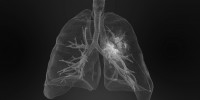
RNA-seq Reveals Lung Cancer Lineage
Non-small cell lung cancer (NSCLC) is the most common form of lung cancer, accounting for approximately 85%. In disease, certain genes have a mutation that drives the cancer. But for which patients does which treatment help, and for which mutations do which types of therapy and drugs help? A new study gives new insights and confirms that RNA sequencing uncovers lung cancer subtypes and that it facilitates drug repositioning.
NSCLC is divided into three subtypes: squamous cell carcinoma, adenocarcinoma, and large cell carcinoma. The main risk factors for NSCLC are smoking and exposure to environmental pollutants. Symptoms of NSCLC can include a persistent cough, chest pain, shortness of breath, and weight loss. Treatment options for NSCLC include surgery, radiation therapy, chemotherapy, and targeted therapy. The prognosis for NSCLC depends on the stage of the cancer at the time of diagnosis, with earlier stages generally having a better outcome.
So, one subtype of lung cancer is adenocarcinoma that arises from mucus-producing cells in the airways. It occurs most often in people who currently smoke or have smoked in the past. Conversely, however, it is also the subtype most common in non-smokers. Thus, when a non-smoker is diagnosed with lung cancer, it is most likely to be adenocarcinoma.
Molecular genetic research of tumor tissue
In the case of lung cancer, molecular genetic research plays an important role, since the genetic material in individual patients can show very individual changes, which we call mutations. These can play a decisive role in further treatment. Tumor or molecular genetics is now an integral part of diagnosing NSCLC, especially adenocarcinoma. It can be determined by sequencing the genetic material from lung cancer tissue.
Certain genes exhibit driver mutations, i.e. changes that drive lung cancer growth. These include the KRAS, EGFR, ALK, MET, ROS1, HER2, BRAF, RET, and NTRK genes. In approximately 60% of patients with adenocarcinoma-type NSCLC, a mutation can be found by researching lung cancer tissue. When mutations of one of the mentioned genes are detected, targeted therapy options are available in trials or also as an already approved drug.
A new study shows: RNA sequencing uncovers lung cancer subtypes and facilitates Drug Targeting
The researchers performed non-negative matrix factorization (NMF) algorithm to classify three clusters of lung adenocarcinoma (LUAD): bronchioid, neuroendocrine, and squamoid. In the main analysis, the researchers included a total of 604 patients from different cohorts with stage IB-IIIA adenocarcinoma of the lung (a malignant tumor arising from glandular tissue). This means that the tumor is 3 to 7 centimeters in size and may have already affected adjacent or distant lymph nodes.
What have the scientists found out? We present the most important findings:
First, the study found that the squamoid cluster has poor prognosis, while the neuroendocrine cluster is characterized by STK11 mutations and 14q13.3 amplifications.
Second, the bronchioid cluster is considered an immune activation due to the highest immune-related genetic perturbation.
Moreover, the neuroendocrine cluster shows resistance to PD-L1 blockade. In contrast, pemetrexed or platinum-based therapies are suitable for bronchioid and squamoid clusters, respectively.
The study also analyzed large-scale drug sensitivity databases. The researchers find that MEK inhibitors exhibited resistance in the bronchioid, while sensitive to the squamous cluster.
 From the therapeutic aspect, the squamoid cluster may benefit from the MEK inhibitors after large-scale drug sensitivity analysis… Combined with our results, dinaciclib is the potential to be repositioned, considering precise subset and reduced toxicity.
From the therapeutic aspect, the squamoid cluster may benefit from the MEK inhibitors after large-scale drug sensitivity analysis… Combined with our results, dinaciclib is the potential to be repositioned, considering precise subset and reduced toxicity.